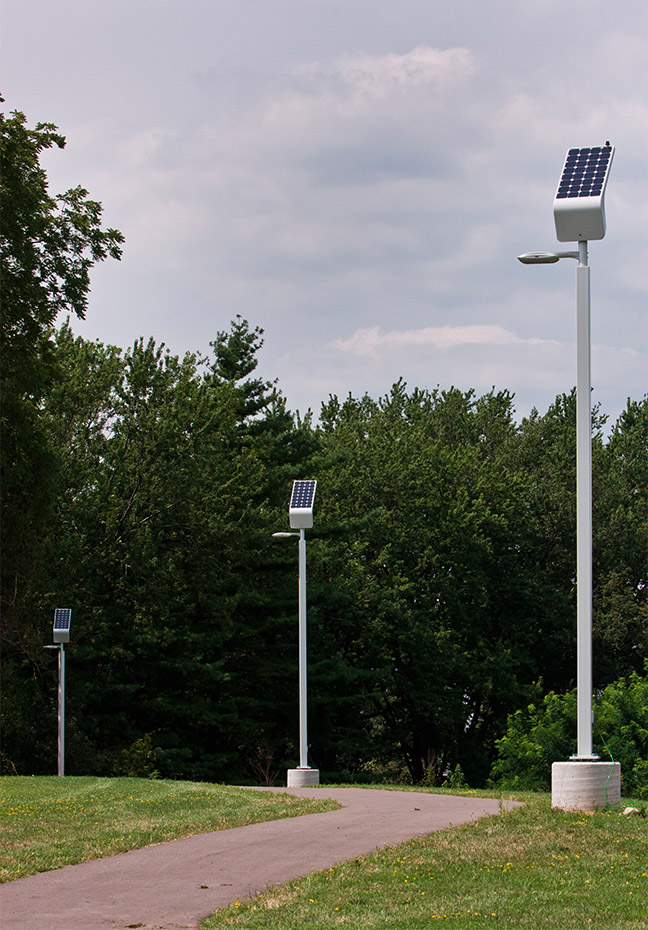Case study
November 2009
Whether lighting a quiet walkway or a busy parking lot, effective illumination can make a world of difference. Safety, security, convenience and aesthetics can all be enhanced by suitable lighting, but sometimes the best spot for a light is far from a convenient source of electricity. Installing power lines, above or below ground, can be a challenge, especially in remote areas, or developed lots where pavement and landscape features can make trenching and cabling a costly and disruptive prospect. Fortunately, advances in photovoltaic and LED lighting technology have produced a convenient alternative: the solar-powered LED light.
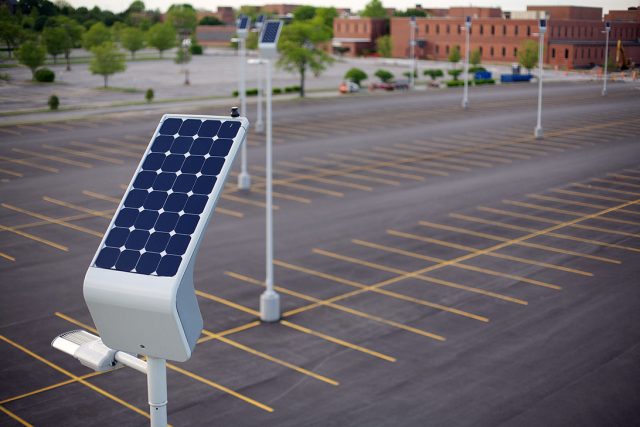
Although solar LED lights have been popular for years as navigational aids for the marine and aviation industries, the underlying technology has only recently advanced to the point where it could illuminate larger outdoor areas in an efficient, cost-effective manner. A new generation of white, high-efficacy LEDs (light emitting diodes) helped make this possible by requiring less energy to produce a brighter and more effective, yet natural and aesthetically pleasing output.
This new innovation, combined with advanced photovoltaic and energy management technology, enabled solar-lighting engineers to specify a smaller photovoltaic panel to gather the sun’s energy, a smaller battery system to store it, and a lighter, more elegant structure to support these components. For designers at Victoria BC-based Carmanah Technologies, these increased efficiencies meant they could also integrate all the required components into a self-contained “solar engine.” As an alternative to external battery boxes, cables and panels, the EverGEN™ solar engine offered all the benefits of a full solar power system in a single, compact device.
To maximize the potential of this photovoltaic power source, the company partnered with Beta Lighting – a Wisconsin-based provider of specification-grade exterior lighting fixtures. Beta Lighting provided a BetaLED™ lighting fixture that was specially designed to accommodate the unique thermal requirements and optical properties of the new LEDs.
As a “dark-sky friendly” light source designed initially for pathways, stairways and other pedestrian-scale applications, the full-cutoff light fixture could deliver an attractive, uniform light output, while reducing or eliminating common lighting challenges such as glare, spillover and skyglow. Intended as a practical stand-alone alternative to traditional hardwired lights, the LED fixture was designed to fulfill stringent output, performance and reliability expectations while operating in accordance with IESNA (Illuminating Engineering Society of North America) light-distribution guidelines.
Ongoing enhancements of this technology have since resulted in larger, higher-output variations, including the EverGEN™ 1520 solar LED light, a powerful new product designed specifically for street and parking lot applications. Introduced this spring at the LIGHTFAIR International conference in New York City, the EverGEN 1520 delivers up to 6,800 lumens of bright, uniform light output, effectively providing a renewable energy alternative to the traditional HID (high intensity discharge) systems commonly used for large-scale roadway and parking lot applications.
In one of the first applications of this new technology, a large California-based facility chose solar over grid-powered lights to address a range of logistical factors in illuminating an employee parking lot. While the need to upgrade lighting was clear, the trenching and cabling required to power the lights posed a challenge. Aside from the prohibitive costs of excavating and replacing the long runs of aging cable serving the site, the lot’s proximity to protected parkland and the presence of cultural artifacts in the vicinity required a nonintrusive, environmentally sensitive solution. In response to a trial installation of EverGEN 1520 lights, a second parking lot was equipped with the solar LED lights as well. By eliminating the need for trenching and recabling, the facility was able to illuminate both parking lots while saving nearly $1.5 million in installation costs.
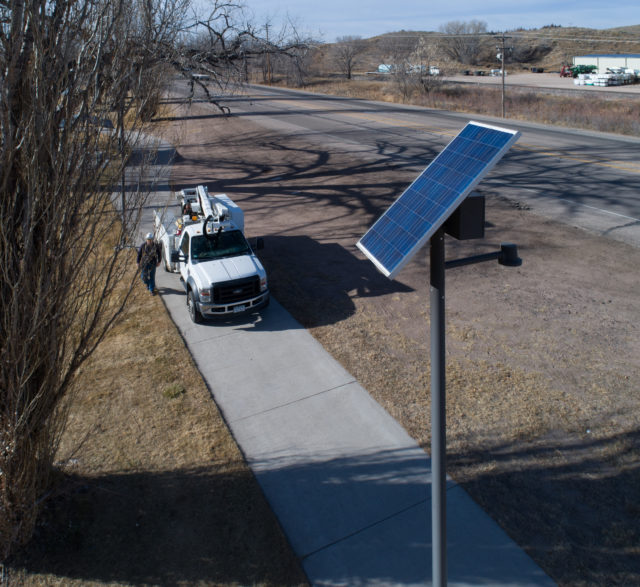
With an array of sizes, styles and outputs now available, solar LED lights are suitable for a range of applications, from providing pedestrian-level lighting for pathways, stairs, transit stops, kiosks and ticket dispensers, to illuminating streets, parking lots, fence lines, and green spaces.
Although solidly constructed as a permanent fixture to endure high winds, rain and other environmental challenges, solar LED lights can also offer a convenient solution for lighting temporary venues or overflow parking areas at special events. Easy to set up, take down, and relocate as necessary, LED lights are extremely durable and consequently, easy to transport without fear of breakage. With minimal environmental impact, there’s also little need for follow-up site repair or remediation. As an alternative to generator-powered portable lights, solar LED lights can offer a clean, silent and reliable lighting solution, free from wires, fumes, noise and fuel deliveries.
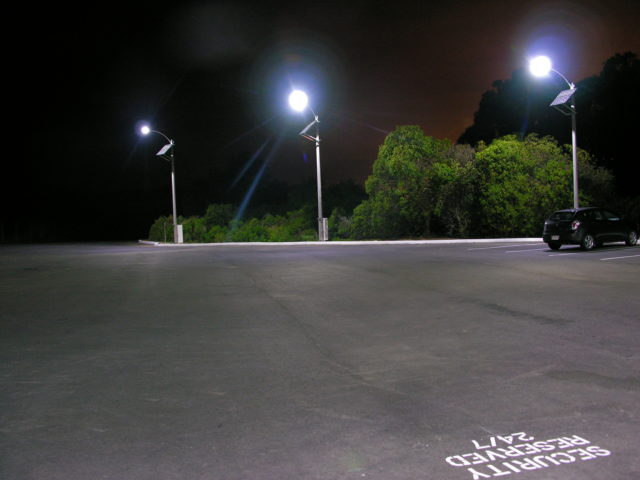
Although the list of potential sites and applications continues to grow steadily, solar technology is not without challenges; variables such as seasonal conditions, geographic location, and shade from buildings or trees can affect performance. Fortunately, these conditions are not insurmountable; today’s solar LED technology provides a range of built-in energy management system (EMS) and control capabilities – from basic on/off control to adaptive dimming and sensing – that can help to balance the relationship between lighting requirements and available energy resources. Some solar LED lights can also be programmed to maximize light output whenever the need is anticipated to be the greatest – for example, during times of highest usage – and conserve energy outside of peak usage hours. Others may monitor environmental conditions and dynamically adjust light output to match the level of solar charging available. Thanks to the versatile characteristics of solid-state lighting (including instant on and variable dimming), motion controlled bi-level lighting is also gaining popularity as a way to conserve energy – both in solar and AC-powered LED systems – by reducing lighting levels when a parking area is not in use. Thanks to these advanced capabilities, a solar LED light can manage the available energy as efficiently as possible to ensure that light is always available when needed.
Another consideration is cost. Because of the specialized components involved, an industrial quality solar LED light will typically cost more to purchase than a standard AC equivalent. Although much of this initial investment can be recouped over time through lower installation, maintenance and operations costs, locations with easy access to grid power or with hard-wired lighting currently in place might find a simple upgrade to an energy-efficient light fixture to be the more affordable short-term option.
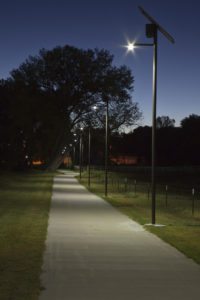
But for new construction, areas with outdated cabling, or locations where grid-based electricity would be too costly, inconvenient or impractical to access, an investment in solar LED lighting can offer considerable advantages. Freedom from the grid means unprecedented versatility and reliability. Solar LED lights install quickly and operate reliably, and with no bulbs to burn out, product maintenance is typically limited to a simple battery exchange after five years. Freedom from power lines and utility power also translates into dependable year-round lighting; in windstorms, local power outages or regional blackouts, solar-powered lights can stay lit even when other lights go out.
While helping to reduce a facility’s overall energy consumption, a renewable energy alternative can also qualify for a range of government stimulus grants or incentives, and even contribute to renewable energy credit programs such as the Leadership in Energy and Environmental Design (LEED) Green Building Rating System.
In a recent example, NASA’s Stennis Space Center, located in south Mississippi, was developing a new Cryogenics Control Center facility and parking lot in accordance with LEED green-building guidelines. Although grid power was readily available onsite, traditional hard-wired lighting options would have exceeded the Center’s total allowable energy consumption and affected its LEED rating. To meet the facility’s stringent lighting requirements without increasing overall electricity usage, NASA engineers identified Carmanah solar LED parking lot lights as the perfect solution. As an off-grid alternative, an installation of EverGEN 1520 lights would provide a reliable source of bright, uniform light while consuming no additional electricity. In addition to providing superior output and performance in accordance with IESNA guidelines, the full-cutoff Dark Sky-friendly design ensures that light is directed only where needed (preventing glare or spillover of light onto neighboring properties or into the night sky), and a built-in energy management capability guarantees optimal lighting performance all year round.

At a time when technological, economic and political factors are converging to provide an unprecedented level of support for renewable energy technology, solar power is emerging as a versatile and practical alternative for a range of general lighting applications. From paths to parking lots, solar LED lights can solve a variety of logistical lighting challenges, helping to conserve energy and control costs in the process. While providing impressive lighting performance from a stand-alone device, each solar-powered light also conveys a positive environmental message, day or night, as an immediately recognizable symbol of renewable energy technology in action.
